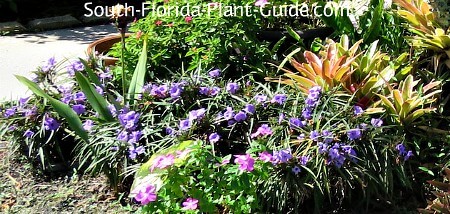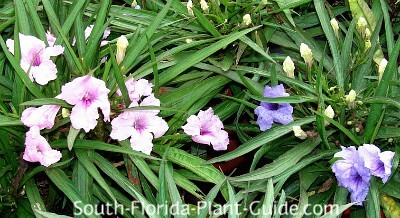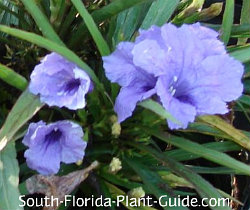Dwarf Mexican Petunia
Ruellia brittoniana
Dwarf Mexican petunia - sometimes called dwarf ruella - is a hardy little groundcover with cottage-garden appeal that blooms all year in warm, sunny locations.

The leaves have a somewhat grassy look, and flowers cluster around the center of each plant and attract butterflies.
Low growing groundcovers like this one look great when planted in a
bed near the entry, as front-of-the-border plants along the foundation,
in a mixed bed or surrounding shrubs.
Usually seen with bright violet flowers, this plant is also available with white or pink blossoms.
You can plant just one variety for a drift of color, or, if all three work with your color scheme, they can be mixed in a garden bed for a very showy effect.

The full size shrub ruella ("Mexican Petunia") is very popular as one of South Florida's prettiest purple flowering plants.
But some homeowners fear it will get away from them since it re-seeds and spreads.
The
dwarf ruella is somewhat more tame. Though it also sends seeds out to
sprout in surprising places, the groundcover's wayward seedlings can be
mowed over in the lawn, removed from garden beds and sprayed with a
herbicide when they spring up from cracks in the sidewalk.
These
chores can be more work than you want to do. If you're more of an
armchair gardener, then this groundcover may not be the one for you.
Plant specs
Dwarf Mexican petunia will grow in full sun to partial shade (though you'll get the most flowers in more sun).
These plants are cold hardy. In Zone 9B they may die back in winter but usually bounce back in spring. Even in Zone 10, some leaves may turn a reddish color during winter's cold snaps.
Dwarf Mexican petunia is salt tolerant and grows to about 10 inches tall.
Spent flowers turn to a tan mush that can dry on the foliage and take a while to disappear.
Plant care
Though it's often described as drought-tolerant, this groundcover prefers regular water, and can even handle "wet feet" in areas that are slow to drain.
If you want to plant it with more drought-tolerant things, add Hortasorb® (pre-swelled with water) to the hole when you plant.
Additionally, you can add topsoil or organic peat humus to each hole before placing the plant to help the roots absorb water.
Trimming is generally not necessary, though a full bed may require that you "clean house" after several years.
If you see lots of leggy shoots fighting each other for sunlight, remove many of the old and leave newer plants to fill in.
Fertilize twice a year - in spring and late summer - with a quality controlled-release fertilizer.
Plant spacing
Place these plants 2 to 2-1/2 feet apart. Ditto for spacing among or in front of shrubs.
Come in from walks and drives about a foot.
Dwarf Mexican petunia will grow in a container, nice surrounding a taller plant.

A.K.A. (also known as): Dwarf Ruella, Dwarf Ruellia
GOOD SNOWBIRD PLANT? YES
COMPANION PLANT SUGGESTIONS: For the purple variety, try dwarf firebush, dwarf yaupon (Schillings) holly, blackberry iris, copper plant, and gold mound.
Other groundcovers you might like: Coral Creeper, Dwarf Chenille
Take a break!
The ultimate guide to low-maintenance plants
and landscaping!
An ebook by
Chase Landre
author of
South-Florida-Plant-Guide.com
Learn more!
Get a greener thumb!
Want to learn more about South Florida planting, watering, fertilizing and dealing with weeds and pests?
See our Gardening How-To section for answers!
Get instant curb appeal!
An ebook by
Chase Landre
author of
South-Florida-Plant-Guide.com
Learn how to get instant curb appeal with fast growing plants and landscaping techniques!


